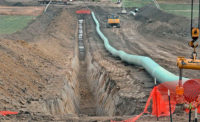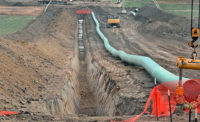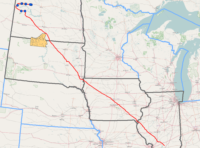The Oglala Sioux tribe has withdrawn as a “cooperating agency” with the U.S. Army Corps of Engineers, in developing a stricter court-ordered environmental impact statement for an easement to allow the $3.8-billion Dakota Access oil pipeline to cross water bodies near tribal lands. Three tribal chiefs called the recently released EIS draft “fatally flawed and irredeemable” in a letter to Acting Assistant Army Secretary Jaime Pinkham.
The chiefs want the Corps to terminate consultant ERM North America, which was hired to write the EIS, citing an alleged conflict of interest based on previous firm statements and court filings against the tribes’ position.
A Washington, D.C. federal court of appeals ruled in January that the Corps decision to prepare a simple environmental assessment for the easement violated the National Environmental Policy Act, which requires that construction permits be issued only after “taking a hard look at the project’s environmental consequences.”
Operating since 2017, Dakota Access moves about 570,000 barrels of crude oil from North Dakota to Illinois daily, including a crossing of Lake Oahe between North and South Dakota, used by the Standing Rock Sioux for drinking water. Based on the now required EIS, the Corps will decide whether to reissue a permit or require an alternative route.
In their Sept. 22 letter, the tribal leaders said they sought to engage “in good faith” with the Corps to fully assess risks and potential impacts of the pipeline. “Our participation in the EIS process and review of the initial draft reveals that the Corps has fundamentally misunderstood the court’s directive,” they said, asking the agency to stop the current analysis that was set to finish in March.
Specifically, the leaders cited ERM membership in the American Petroleum Institute in 2017 when the trsde group filed a friend of the court brief on behalf of operator Energy Transfer Ltd. in the litigation opposing the easement. “In essence, ERM is an agent of the Dakota Access Pipeline,” the tribes said, also noting previous testimony of an employee of Natural Resources Group, owned by the consultant, who said “the project is not likely to pose a threat of serious injury to the environment.”
A Corps spokesperson declines comment on whether it has responded to the letter or on any change in consultant or project status. ERM and Energy Transfer did not respond to ENR.
The Corps typically uses outside contractors to do all the technical work for an EIS, says Robert Vining, retired chief of the Corps’ civil works program and now a consultant for Dawson & Associates, an environmental permitting firm in Washington, D.C. Contractor work is done under oversight of the Corps, which “owns” the resulting product and is accountable to make sure it complies with all NEPA regulations, he says.
"The last thing the Corps wants is to have the integrity of its work questioned,” Vining says, contending the agency is “aggressive” in assuring objectivity of its consultants and has a system to rate them.
The tribes called the draft EIS by ERM an “advocacy document” prepared to justify that the pipeline remain at its current easement location on treaty lands upriver of Standing Rock Sioux and Cheyenne River Sioux reservations and near the Oglala Sioux water intake.
“In example after example, the document entirely ignores critical technical and cultural information that we have presented to the Corps,” the letter says, also claiming the agency is withholding key technical analysis from the tribes and that the draft EIS has “substantive flaws.”
The tribes want the U.S. Interior Dept. brought in as a co-equal cooperating agency to assist the Corps on the EIS, claiming the current draft “is based on a secretive record of correspondence and one-sided technical data prepared by [Dakota Access] and unavailable for review and comment by us.”
The Interior Dept. and US Environmental Protection Agency must review the EIS under a formal state and agency review process, says Vining.






Post a comment to this article
Report Abusive Comment